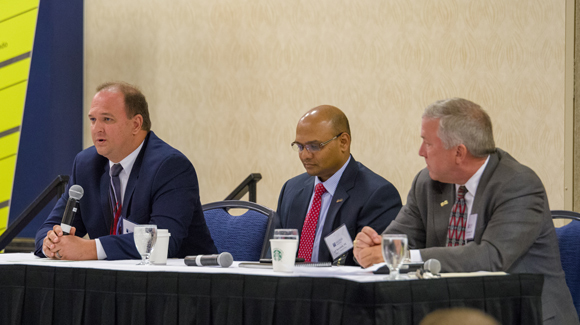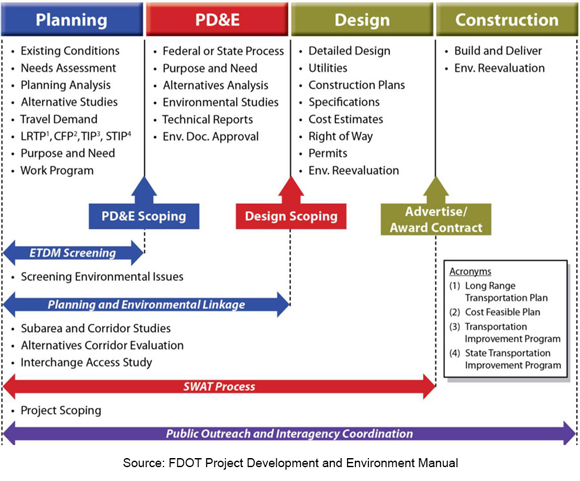Three FDOT District Secretaries Shine Spotlight on Future of I-4

A recent transportation conference held in Orlando highlighted the ever-growing importance of the two major highway construction projects that are remaking 60 miles of Interstate 4 (I-4) in Central Florida.
The “New Leaders of the I-4 Corridor” conference drew numerous attendees from the fields of transportation, engineering, construction and communications. The event was organized by the Society for Marketing Professional Services and the Central Florida Chapter of WTS. WTS describes itself as “an international organization dedicated to building the future of transportation through the global advancement of women.”
In a rare occurrence, the three District Secretaries of the Florida Department of Transportation (FDOT) whose districts include I-4, shared the speakers platform. A recurring theme of the discussion was the continued importance of the interstate in fast-growing Florida.
District 5 Secretary Mike Shannon, P.E., whose area includes Orange, Osceola, Seminole and Volusia counties along the I-4 corridor, talked about the I-4 Ultimate and I-4 Beyond the Ultimate projects. The two projects will remake 60 miles of I-4 from U.S. 27 in Polk County to State Road 472 in Volusia County. He noted that while the two projects will significantly increase safety and mobility, improvements in other areas also will be needed to continue to manage traffic.
District 1 Secretary L.K. Nandam, P.E., whose district includes Polk County on the I-4 corridor, said that District 1 is studying extending managed lanes on I-4 through Polk County so it could one day connect with managed lane projects in the Orlando and Tampa areas.
District 7 Secretary David Gwynn, P.E., whose area includes Tampa and St. Petersburg, noted that several construction projects are planned to help maintain traffic flow in the growing metropolitan area.
|
|
#I4Beyond Joins Twitter

I-4 Beyond the Ultimate project content is now being posted on a weekly basis to the revamped “I-4 Ultimate and Beyond” Twitter account @I4Ultimate.
Followers will have a steady stream of I-4 Beyond the Ultimate project information such as key dates, public meetings, infographics and other content. The Twitter account already provides updates on construction detours for the 21-mile I-4 Ultimate project.
For the average driver, who is not yet familiar with I-4 Beyond the Ultimate, it might be easiest to think of it as an extension of the I-4 Ultimate project. I-4 Beyond the Ultimate extends the eastern endpoint of the managed lanes another 20 miles and also adds 20 miles to its western endpoint. Both I-4 Ultimate and I-4 Beyond the Ultimate will improve pavement, ramps and interchanges, and both projects will maintain the current six non-tolled lanes while adding four dynamic tolled Express Lanes (two in each direction). The Florida Department of Transportation oversees both projects.
Join in the conversation with more than 2,000 users following @I4Ultimate by tweeting us, retweeting information and using the hashtag #I4Beyond. The Twitter page can be found at https://fdot.tips/twitter.
If your organization would like to receive customized weekly or monthly I-4 Ultimate or I-4 Beyond the Ultimate Twitter content to post, please reach out to us at http://fdot.tips/I4Contact.
|
|
The Planning Process Behind the I-4 Beyond the Ultimate Project

Stage 1: Planning – Large projects such as the I-4 Beyond the Ultimate are preceded by long-range studies. Some have been going on for 20 years or more, as the Florida Department of Transportation (FDOT) and other transportation planning agencies monitor population growth, residential development and traffic patterns to anticipate transportation needs.
Stage 2: PD&E – The Project Development and Environment (PD&E) study takes into consideration options for design and location. Each option is analyzed for its environmental, social and economic impact. Proposals also are compared to a no-build option. The Federal Highway Administration (FHWA) reviews the documentation and recommendations of the study. As of last year, the I-4 Beyond the Ultimate project completed this stage and began moving into the design phase.
Stage 3: Design – Detailed design and construction plans are developed. Cost estimates are calculated. Right of way needs are analyzed and purchasing may begin if funding is available. The project is advertised for potential bidders and, after a meticulous review, the contract or contracts may be awarded. The I-4 Beyond the Ultimate project is divided into multiple design segments. Check on the timeline and funding availability of each.
Stage 4: Construction – The building of the roadway, bridges and drainage structures. This work also can include maintenance of traffic plans, landscaping, and creating an electronic backbone to support current and future needs.
All Stages: Public Involvement – Throughout all four stages, FDOT seeks to keep the public informed through several communication platforms and by holding public meetings or open houses to explain plans, answer questions and receive comments.
|
|
|